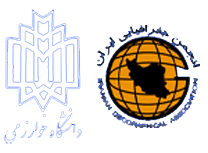دوره 25، شماره 78 - ( 7-1404 )
جلد 25 شماره 78 صفحات 65دوره44فصل__Se |
برگشت به فهرست نسخه ها
Download citation:
BibTeX | RIS | EndNote | Medlars | ProCite | Reference Manager | RefWorks
Send citation to:



BibTeX | RIS | EndNote | Medlars | ProCite | Reference Manager | RefWorks
Send citation to:
Behdost F, Ziari K, Hataminejad H, Faraji sabokbar H A. (2025). Urban competitiveness planning with emphasis on tourism for urban branding(Case study: Kermanshah city). jgs. 25(78), 44-65. doi:10.61186/jgs.25.78.4
URL: http://jgs.khu.ac.ir/article-1-4052-fa.html
URL: http://jgs.khu.ac.ir/article-1-4052-fa.html
بهدوست فرانک، زیاری کرامت اله، حاتمینژاد حسین، فرجی سبکبار حسنعلی.(1404). برنامهریزی رقابتپذیری شهری از طریق گردشگری بهمنظور برندسازی شهری (مطالعه موردی شهر کرمانشاه) تحقیقات کاربردی علوم جغرافیایی 25 (78) :65-44 10.61186/jgs.25.78.4
1-
2- دانشکده جغرافیای دانشگاه تهران، تهران خیابان قدس کوی آذین دانشکده جغرافیای دانشگاه تهران ،zayyari@ut.ac.ir
3- دانشکده جغرافیا دانشگاه تهران، تهران خیابان قدس، کوچه آذین، دانشکده جغرافیا دانشگاه تهران
2- دانشکده جغرافیای دانشگاه تهران، تهران خیابان قدس کوی آذین دانشکده جغرافیای دانشگاه تهران ،
3- دانشکده جغرافیا دانشگاه تهران، تهران خیابان قدس، کوچه آذین، دانشکده جغرافیا دانشگاه تهران
چکیده: (8395 مشاهده)
امروزه باتوجه به شرایط جهانیشدن، برندسازی شهرها باتوجه به توانهای گردشگری از اهمیت بسزایی برخوردار است و اکثر مناطق با برنامهریزی در این زمینه سعی در توسعه اقتصادی و محرومیتزدایی بیشتر با استفاده از گردشگری دارند. در این پژوهش باتوجه به پتانسیلهای بالای شهر کرمانشاه در زمینه گردشگری درصدد برنامهریزی راهبردی برندسازی شهری با استفاده از گردشگری بودیم. روش پژوهش در این مطالعه توصیفی- تحلیلی و هدف آن کاربردی بود. دادهها و اطلاعات موردنیاز از منابع کتابخانهای و پیمایشی (پرسشنامه و مصاحبه) از متخصصین جمعآوری شد. تکنیک متاسوات استفاده شد که براساس رهیافت داخل به خارج و دیدگاه مبتنی بر منابع است رقابتپذیری شهرها و مناطق را فراهم میکند. شهر کرمانشاه دارای قابلیتهای بالایی برای جذب گردشگری بهمنظور رقابتپذیری شهری، منطقهای و جهانی است. یافتههای این پژوهش نشان میدهد در بین قابلیت و تواناییهای شهر کرمانشاه وجود بناهای تاریخی و فرهنگی مانند طاقبستان، تکیهها، خانههای تاریخی، موزهها، نقش مرکزیت صنایعدستی، تشابهات فرهنگی با افراد ساکن عراق و ترکیه، فرهنگ، اعتقادات و آدابورسوم بهعنوان پتانسیلهای گردشگری کرمانشاه دارای چهار ویژگی (VIRO) هستند درواقع این ویژگی بیشترین میزان تناسب راهبردی با متغیرهای کلان مؤثر بر جذب گردشگر و رقابتپذیری شهری از طریق گردشگری در شهر کرمانشاه دارا بود. در بین متغیرهای کلان تأثیرگذار پاندمی کرونا، وجود تحریمها علیه ایران، تغییرات آبوهوایی و بلایای طبیعی و کمبود اعتبارات دارای بیشترین میزان تأثیر بر رقابتپذیری شهری کرمانشاه هستند باتوجه به منابع و متغیرهای کلان تأثیرگذار نقشه تناسب راهبردی ترسیم شد و راهکارهای مناسب ارائه گردید.
نوع مطالعه: كاربردي |
موضوع مقاله:
برنامه ریزی توریسم
فهرست منابع
1. اسکندری ثانی، محمد؛ پیلهور، علی اصغر؛ رضائی نصب،آزاده(1396) . سنجش مولفههای موثر بررقابتپذیری منطقهای درجهت توسعه پایدارموردشناسی: استان خراسان شمالی، نشریه آمایش شهری منطقهای،7 (24)، 70-57
2. افتخارنیا، مینا ؛ زیاری، کرامت الله ؛ نادری، مجید(1400) . تبیین چارچوب رقابت پذیری پایدار در راستای توسعه فضایی ناحیه اراک، نشریه تحقیقات کاربردی علوم جغرافیایی، 21(62)، 357-381
3. رحمتی، صفرقائد، خاوریان گرمسیر، امیررضا (1395). نقش تکنیک متاسوات در برنامهریزی راهبردی شهر یزد، نشریه برنامهریزی وآمایش فضا، 20(1) ، 205-179
4. فیضی ، سلمان ؛ حیدریچیانه ،رحیم ؛ روستایی، شهریور، (1399). بررسی تاثیر برندسازی مقاصد بر توسعه گردشگری شهری (مورد مطالعه کلانشهر تبریز)، تحقیقات کاربردی علوم جغرافیایی, 60(20), 229-252.
5. متقی ، افشین ، انصاری ،زهرا ؛ قربانی سپهر، آرش ؛دلالت، مراد (1400) . نگرش ژئوپلیتیکی در رقابت گردشگری شهری با استفاده از شاخص جاذبه گردشگری (مورد بررسی: تهران با سایر استان ها)، نشریه تحقیقات کاربردی علوم جغرافیایی, 21(61), 95-117.
6. هاسپرس، گرت جان .(1391 ) . شهرهای خلاق مکانهای پرورش یافته در اقتصاد دانش، مترجم: سعید حسین آبـادی، رشـد آمـوزش جغرافیـا، 25(4) ، 35-26
7. Agarwal, R., W. Grassl & J. Pahl, (2012 )"Meta-SWOT: Introducing a New Strategic Planning Tool", Journal of Business Strategy, No. 33(2), pp. 12-21, [DOI:10.1108/02756661211206708]
8. Anttiroiko, A. V. (2014) , The political economy of city branding ,Routledge. [DOI:10.4324/9780203782187]
9. Ashworth, G., & Kavaratzis, M. (2009) , Beyond the logo: Brand management for cities, Journal of Brand management, 16(8), 520-531 [DOI:10.1057/palgrave.bm.2550133]
10. Barney, J. B., (1991) "Firm Resources and Sustained Competitive Advantage", Journal of Management, Vol. 17, No. 1, pp. 99-120. [DOI:10.1177/014920639101700108]
11. Begg, I. (1999) , Cities and competitiveness, Urban studies, 36(5-6), 795-809 [DOI:10.1080/0042098993222]
12. Bloomberg, , (2012) , SWOT, PESTEL, Porter's 5 Forces and Value Chain, .pp. 1-16,
13. http://cfcdn.ivoryresearch.com/wp-content/uploads/2013/04/Bloomberg-Business sample1.pdf
14. Cucculelli, M., & Goffi, G. (2016) , Does sustainability enhance tourism destination competitiveness? Evidence from Italian Destinations of Excellence, Journal of Cleaner Production, 111, 370-382. [DOI:10.1016/j.jclepro.2014.12.069]
15. Echtner. M. and Ritchie. J. R. (2003) , The Meaning and Measurement of Destination Image, The World Tourism Education & Research Centre, The University of Calgary
16. Jones, G., Hill, C., (2013). "Strategic Management Theory: An Integrated Approach" Cengage Learning, Cengage Learning.
17. Gildo siesdedos & Pablo Vaggino,( 2005) "the city branding processes : the case of Madrid" , 4st isocrap congress
18. Kim, N. (2012) , Tourism destination competitiveness, globalization, and strategic development from a development economics perspective. (Submitted in partial fulfillment of the requirements for the degree of Doctor of Philosophy in Recreation, Sport and Tourism, University of Illinois), 39
19. Taylor, J. B. (2007, June) , Globalization and monetary policy: Missions impossible,In NBER Conference on the International Dimensions of Monetary Policy, Girona, Spain (pp. 11-13).
20. Kresl, P. K., & Fry, E. H. (2005,) The urban response to internationalization, Edward Elgar Publishing. [DOI:10.4337/9781845426767]
21. Kozak, Metin and Mike Rimmington (1999), "Measuring tourist
22. destination competitiveness: conceptual considerations and empirical
23. findings," Hospitality Management, 18, 273-283
24. Lever, W. F., & Turok, I. (1999), Competitive cities: introduction to the review [DOI:10.1080/0042098993213]
25. Harris, N. (2007), City Competitiveness. Originally drafted for a World Bank study of competitiveness in four Latin American cities.
26. Isoherranen, V., (2012), Strategic Analysis Frameworks for Strategic Orientation and Focus, University Of Oulu,
27. Sassen, S. (2011), Cities in a world economy, 2nd ed. Pine Forge Press: Sage Publications.
28. Shi, Y., Zhong, L., Chen, T., & Yu, H. (2016), Tourism competitiveness evaluation and spatio-temporal characteristics of Chinese border counties. Chinese Geographical Science, 26(6), 817-828. [DOI:10.1007/s11769-016-0822-1]
29. Poon, A. (1993) , Tourism, technology and competitive strategies. CAB international. [DOI:10.1079/9780851989501.0000]
30. Porter, M. (1995), The competitive Advantage of the Inner Cities. Harvard Business Review, 73(3). 55-71
31. Prilenska, V. (2012), City Branding as a Tool for Urban Regeneration: Towards a Theoretical Framework. Architecture & Urban Planning, (6). [DOI:10.7250/aup.2012.002]
32. Ren, Fu, et al. (2014), Measuring and Analysis of Urban Competitiveness of Chinese Provincial Capitals in 2010 under the Constraints of Major Function-Oriented Zoning Utilizing Spatial Analysis, Sustainability 6, 3374-3399. [DOI:10.3390/su6063374]
33. Ritchie, J. R. B. & Crouch, G. I. (2003), The Competitive Destination: A sustainable tourism perspective (First.). CABI. [DOI:10.1079/9780851996646.0000]
34. Ritchie, J.B. and Crouch, G.I. (1993), Competitiveness in international tourism:A framework for understanding and analysis, World Tourism Education and
35. Research Centre, University of Calgary
36. Virgo, B., & De Chernatony, L. (2006), Delphic brand visioning to align stakeholder buy-in to the city of Birmingham brand. Journal of Brand Management, 13(6), 379-392. [DOI:10.1057/palgrave.bm.2540280]
37. Webster, D., & Muller, L. (2000), Urban competitiveness assessment in developing country urban regions: The road forward, Urban Group, INFUD. The World Bank, Washington DC, July, 17, 47.
38. Weng, P. W. P. (2019), Destination Competitiveness: An Antecedent or the Result of Destination Brand Equity? , In Positioning and Branding Tourism Destinations for Global Competitivenes, (pp. 49-73). IGI Global [DOI:10.4018/978-1-5225-7253-4.ch003]
39. Zhang, H., Gu, C. L., Gu, L. W., & Zhang, Y. (2011) , The evaluation of tourism destination competitiveness by TOPSIS & information entropy-A case in the Yangtze River Delta of China, Tourism Management, 32(2), 443-451 [DOI:10.1016/j.tourman.2010.02.007]
40. Zenker, S., & Martin, N. (2011) , Measuring success in place marketing and branding, Place Branding and Public Diplomacy, 7(1), 32-41 [DOI:10.1057/pb.2011.5]
ارسال پیام به نویسنده مسئول
| بازنشر اطلاعات | |
 |
این مقاله تحت شرایط Creative Commons Attribution-NonCommercial 4.0 International License قابل بازنشر است. |

This work is licensed under a Creative Commons — Attribution-NonCommercial 4.0 International (CC BY-NC 4.0)






